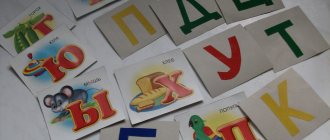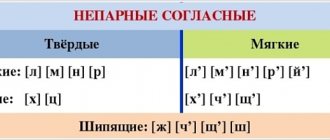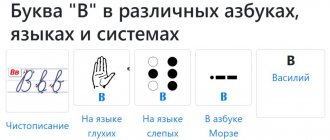4.2
Average rating: 4.2
Total ratings received: 128.
4.2
Average rating: 4.2
Total ratings received: 128.
As you know, speech sounds can be divided into vowels (pronounced only by voice) and consonants (noise is involved in their pronunciation). Many consonants can be paired according to their characteristics, but not all.
The material was prepared jointly with a teacher of the highest category, Kuchmina Nadezhda Vladimirovna.
Experience as a teacher of Russian language and literature - 27 years.
Paired and unpaired consonants according to deafness-voicing
It should be noted right away that there are only four such sounds that are unpaired in all respects. We'll talk about them at the end of the article. The majority fits into a couple based on one characteristic, but not on another. Therefore, it makes no sense to write about the consonant “unpaired” - you need to indicate on what basis.
Consonants differ in deafness and voicedness. This means that when pronouncing some of them, more voice is used (sonorant, voiced), while others use more noise (voiceless) or even just one noise (hissing).
Sonorants are very sonorous consonants, they have a lot of voice, but little noise.
Two sonorant consonants - [L] and [R] - can even, under some circumstances, form a syllable, that is, behave like vowels. Surely you have come across the erroneous spelling “theator”. It is explained precisely by the fact that [P] in this word is syllabic. Other examples are the words “Alexander”, “meaning”.
Unpaired voiced consonant sounds are just sonorant sounds. There are five of them:
- [L],
- [M],
- [H],
- [R],
- [Y].
Sometimes [Y] is not classified as sonorant, but it still remains voiced unpaired. Let's look at the table.
| voiced | b | V | G | d | and | h | th | l | m | n | R | – | – | – | – |
| deaf | P | f | To | T | w | With | – | – | – | – | – | X | ts | h | sch |
It shows that, in addition to unpaired voiced sounds, there are also unpaired unpaired sounds. Most of them are fizzy; Only the dull unpaired consonant sound [Ts] does not belong to hissing sounds.
In this article we consider only Russian speech sounds. In other languages, the pairing may be different. For example, in the Tibetan language there is a voiceless pair to a voiced [L].
Paired consonants
What does consonant pairing mean? Two letters that are similar in sound and, when pronounced, take similar positions with the tongue, are called paired consonants. The pronunciation of consonants can be divided into one-stage (lips and tongues are involved in their creation) and two-stage - the ligaments are connected first, then the mouth. Those cases when, during pronunciation, mouth movements coincide and create pairs.
Summary table of paired consonants taking into account hardness and softness
| Sound | [b] | [b'] | [V] | [V'] | [G] | [G'] | [d] | [d'] | [h] | [z'] | [and] |
| Ch. | [P] | [P'] | [f] | [f'] | [To] | [To'] | [T] | [T'] | [With] | [With'] | [w] |
In speech, it is common not to pronounce each letter, but to “eat” it. This is not an exception only for Russian speech. This is found in almost all languages of the world and is especially noticeable in English. In Russian, this effect is subject to the rule: paired consonant sounds replace (auditory) each other during speech. For example: love – [l' u b o f'].
But not everyone has their own pair. There are some that are not similar in pronunciation to any others - these are unpaired consonants . The reproduction technique differs from the pronunciation of other sounds and combines them into groups.
Paired consonants
Hardness-softness pairs
In addition to deafness and voicedness, Russian consonants form pairs based on hardness and softness.
This means that some of them are perceived by ear as softer sounding. Then we usually indicate this in writing somehow: for example, we write a soft sign or one of the vowels E, Yo, Yu, Ya.
Oral speech is primary (everyone understands that it appeared before written speech), therefore it is incorrect to say: “The sound [N'] in the word HORSE is soft, because it is followed by b.” On the contrary, we write b because H' is soft.
According to hardness-softness, consonants also form pairs. But even in this case, not everything. In the Russian language there are unpaired soft and unpaired hard consonants.
Unpaired hard consonant sounds are mainly hissing sounds ([Zh], [Sh]) and [C]. They always form at the far palate.
But in the ancestor of our language, Old Church Slavonic, on the contrary, [ZH] and [SH] were always soft and did not have a hard pair. Then [K], [G] and [X] were not soft. Nowadays you can find (once the only possible) pronunciation with a soft [Zh'] [DROZH'ZH'I] or [DOZH'] (rain), but this is no longer necessary.
Unpaired soft ones are [Y'] and again hissing [H'] and [Ш'].
That is, all hissing ones are either always hard or always soft. The letter b after them does not indicate softness, it performs a grammatical function (for example, even without knowing what “baldness” is, anyone will immediately say that this is a feminine word, because in the masculine gender b is not placed after hissing words). Hard unpaired hissing consonant sounds in a word may have b with them, but this does not mean that they should soften. This means that we have a 3rd declension noun, an adverb or a verb.
Unpaired soft consonant sounds in a word make you want to put b after them, which is often not required. Therefore, it makes sense to remember that in combinations CHK, CHN, etc. b after h is not needed.
Hard and soft consonant sounds: table, example words
All voiced, voiceless sounds of consonants, except hissing ones, are hard and soft.
For example: the hard sound [ b ] was – [ b `] beat; [ t ] current – [ t `] flow. When you pronounce hard consonants, the tip of your tongue is applied to the roof of your mouth. And soft ones are obtained when the middle part of the tongue is pressed against the palate. A soft or hard consonant is determined by the letter following the consonant. In turn, vowel letters also have their own pairs: ы-и , а-я , е-е , у-у , о-е .
What vowels give hardness to the consonant sound?
Some vowels have two sounds, such as: ( я, ё, yu, e ), pronounced in the following ways: soft sound [ й ] + a paired vowel of the above vowels: e, o, u, a . Or a softening sign + a paired vowel.
For example, the word is raccoon . It is pronounced like this: [ th ] [ e ] [ n ] [ o ] [ t ]. Or the word - mud . It is pronounced as: [ t' ] [ ы ] [ n ] [ a ]. The letters: ы, у, а, о, е have only one sound, therefore they do not in any way affect the consonant sound in front.
An example of soft, hard sounds: Linden - skis , chalk - mayor , smoke - business . Phonetic transcription: [ L'ypa ] - [ ski'y ], [ m'el ] - [ mayor ], [ smoke ] - [ d'elo ]. From the examples it is clear that hard consonant sounds come before s, o, e, a, u, and soft consonants come before: i, ya, e, yu, e .
Softer sounds can also appear before a soft sign, for example: sprat, brush, laziness, tulle, moth.
Vowels that soften a consonant sound
When after a consonant letter - s - m , then s is always hard, even when m is soft. Sounds: m and s are considered hard if they are written at the very end of a word, examples: som , tom , ear , pole .
Borrowed words with the vowel -e are usually pronounced firmly. Example: fake , [ fey'k ].
Consonant sounds are always soft if they are written before: ь. The exception is the following letters: zh, ts, sh - they are always hard. And soft ones are sch, th, h . Examples: sorrel , iodine , seagull .
Hard consonants that are not affected by the subsequent letter
Hard consonant sounds can form a soft pair; see the table below and examples of these letters below.
Table
| Hard consonants | Soft consonants | Examples with hard and soft consonants |
| [b] | [b'] | life - beat, be - beat |
| [P] | [P'] | dust - drank, pan - drunk |
| [V] | [V'] | howled - pitched, cotton wool - Vyatka, ready - cook |
| [f] | [f'] | lantern - eagle owl, effect - fact |
| [d] | [d'] | water – vodi, hole – dinar |
| [With] | [With'] | scales - whole, cheese - sulfur |
| [h] | [z'] | cart - carry, dawn - zero |
| [n] | [n'] | burden - nyasha, horse - horse |
| [G] | [G'] | hump - coat of arms, leg - legs |
| [To] | [To'] | forty - magpie, cat - whale |
| [m] | [m'] | mol - chalk, small - mil, mat - mint |
| [T] | [T'] | beat - beat, fog - darkness |
| [l] | [l'] | mole - moth, elk - forest |
| [X] | [X'] | ear - ears, good - cunning |
| [R] | [R'] | dew - rice, lynx - duckweed. |
Remember : Solid unpaired letters include consonants: [ zh ], [ w]
]
.
_
_ _ _ _ _ _
Soft consonant sounds regardless of the vowel behind them
The sounds are “completely unpaired”
In the Russian language, most consonants are either paired according to both characteristics, or paired according to one characteristic and unpaired according to another. For example , in the word [P'EN'] (stump), the sound [P'] is paired both in deafness-voicing (P' - B'), and in hardness-softness (P' - P), and the sound [N'] paired in hardness-softness (H' - N), but unpaired in deafness-voicedness.
However, there are several sounds that are unpaired in both characteristics. These are the sounds [Y'] (unpaired voiced, unpaired soft), [Ch'] (unpaired soft, unpaired deaf), [Sh'] (unpaired soft, unpaired deaf) and [Ts] (unpaired hard, unpaired deaf). Such sounds are often made in Russian language Olympiads. For example, “Guess the sound by its characteristics: unpaired hard, unpaired dull.” We already see that this is [C].
Deaf
Quiet, it’s quite difficult to shout them. The vocal cords do not obstruct the movement of air from the lungs, and sound is formed by changing the shape of the lips and the position of the tongue.
Voiceless in Russian: [k], [p], [s], [t], [f], [x], [ts], [sh]. The easiest way to remember is a phrase, and not a set of letters, “Styopka, do you want a cheek? Fi!” containing them all.
An example in which all consonant sounds are unvoiced: rooster, honeycomb, pin.
This is interesting! How phonetic analysis of a word is done: an example of sound analysis
Test on the topic
- /10
Question 1 of 10Choose the correct statement
Start test
Hall of Fame
To get here, take the test.
- Vasilisa Kozlova
8/10
- Aliya Karashaeva
10/10
- Sergey Efremov
8/10
- Olga Gorkova
9/10
- Liliya Golomolzina
10/10
Spelling problems
In words with paired consonants in terms of voicedness and voicelessness, it is quite easy to make a mistake if one sound is heard, but you need to write another. Difficulties can arise when a paired consonant comes before a deaf person or when a word ends with it (tetra[d]ka, bread[b]).
To correctly select a paired consonant when writing a word, controversial sounds must be checked. In difficult cases, the word is changed or a single root word is selected so that the paired consonant appears before the vowel sound (or before the sonorant sound: before th, m, n, r, l).
You can use different ways to select test words:
- Change to plural:
tooth - teeth, train - trains; - Replace with a diminutive:
bed - bed, bread - bread; - Choose a single-root adjective:
carrot - carrot, labor - difficult; - Change according to the principle small - large:
snowdrift - snowdrift, fur coat - fur coat; - Use the word “no” to change:
bicycle - no bicycle, watchman - no watchman.
Letter and sound Y
The letter Y (and short) means the sound [th']: paradise [paradise'].
The letter Y is written:
- At the beginning of the words: iodine, yogurt.
- In the middle of words, before consonants: Laika, T-shirt, coffee pot.
- At the end of the words: paradise, may, yours.
The sound [th'] is more common than the letter Y, since it appears in words where there is no letter J, but there are vowels Ya, E, Yu and E. Let's consider in what cases the sound [th'] occurs in words that do not contain the letter Y:
- The vowels Ya, E, Yu and Yo are at the beginning of the word: yama [y'ama].
- The vowels I, E, Yu and E come after the vowels: yours [your'o].
- The vowels Ya, E, Yu and Yo come after the dividing hard sign (Ъ): entry [vy'ezd].
- The vowels Ya, E, Yu and Yo come after the soft separating sign (b): pours [l'y'ot].
- The vowel I comes after the soft separating sign (b): beehives [ul'y'i].
Sonorant, noisy, hissing and whistling consonants
In the Russian language, sonorant, noisy, as well as hissing and whistling consonant sounds are also distinguished. We will give a definition of each of the named types of consonants, and also list which consonants belong to one or another type.
Sonorant consonants
Sonorant consonants are voiced unpaired consonants.
There are 9 sonorant sounds in total: [th'], [l], [l'], [m], [m'], [n], [n'], [r], [r'].
Noisy consonants
Noisy consonant sounds are divided into voiced and voiceless. Voiceless noisy consonants include 16 sounds: [k], [k'], [p], [p'], [s], [s'], [t], [t'], [f], [f '], [x], [x'], [ts], [ch'], [sh], [sh'], and noisy voiced consonants include 11 sounds: [b], [b'], [ c], [v'], [g], [g'], [d], [d'], [g], [h], [h'].
Hissing consonants
There are a total of 4 hissing consonant sounds in the Russian language: [zh], [ch'], [sh], [sch']. They all resemble hissing to the ear, which is why they are called hissing consonants.
Sibilant consonants
Whistling consonants
Whistling consonants
Whistling consonant sounds [з] [з'] [с] [с'] [ц] are, in their pronunciation, front-lingual, fricative. When articulating hard sounds [z], [s] and [ts], the teeth are exposed, the tip of the tongue leans against the lower teeth, and the back of the tongue is slightly arched, the lateral edges of the tongue are pressed against the upper molars. The air passes through, creating frictional noise.
When articulating soft sounds [s'] and [z`], the same thing happens, but the back of the tongue rises to the hard palate.
When pronouncing voiced sounds [з] and [з`], the vocal cords are closed and vibrate, but the velum palatine is raised. Other articles on the topic Russian language
Rule
All paired consonants in terms of voicedness/voicelessness can be voiced or deafened depending on their position in the word.
Spelling of paired consonant sounds in terms of voicedness/voicelessness is a spelling pattern that requires a test word. This spelling concerns the paired consonant at the root of the word (in the middle and at the end of the word).
Paired sounds are deafened in the following cases:
- words with a paired consonant at the end
( for example, in the word “tooth” a paired unvoiced consonant sound [p] is pronounced, since the consonant sound is at the end of the word) - before voiceless consonant sounds
( for example , in the word “sponges” a paired voiceless consonant sound [n] is pronounced, since it is located before the voiceless consonant sound [k]).
Paired sounds are voiced in the following case: before voiced consonant sounds (for example, in the word “make” a paired voiced consonant sound [z] is pronounced, since it is located before a voiced consonant sound [d]).
The examples given (tooth - zu[p], sponges - gu[p]ki, do - [z]de) help prove that sounds and letters do not always coincide.






